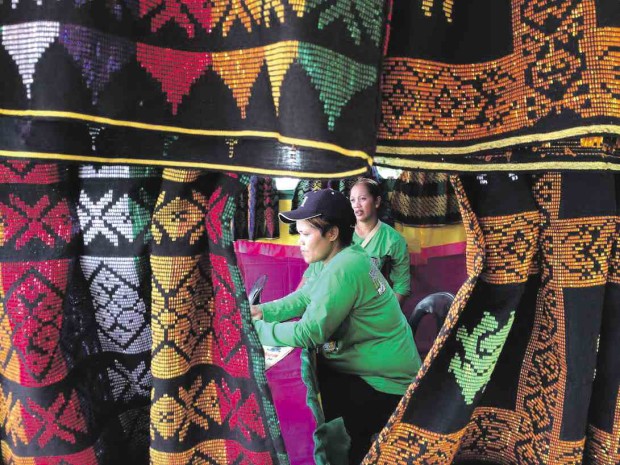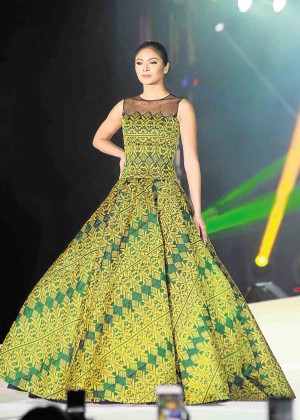‘Inaul’ goes mainstream

‘INAUL’ WALL Women selling their products at the first Inaul festival in Buluan, Maguindanao. —NICO ALCONABA
BULUAN, MAGUINDANAO—A traditional Maguindanao cloth woven the way it had been for centuries slipped out of obscurity to be featured as material for gowns worn by Miss Universe candidates during a fashion show in Davao City last month.
When the beauty queens strutted wearing inaul gowns prior to coronation night, little did they know that it would spur big ideas in the province that produces it, among these a festival in honor of what could be Maguindanao’s most well-crafted product.
Inaul is handwoven according to designs that are centuries-old. Special threads, called sutra, are used, separated by fine bamboo fabric combs and extending to nearly 19-meter yarns.
Symbol of strength
Inaul symbolizes strength as it is made to last. Given as a gift, it is meant to last for a lifetime.
“Giving inaul as a gift is expressive of the giver’s wish for long life and prosperity to the receiver,” an old Moro woman once said.
One design is given to boys on circumcision day. If given by a woman not related to the boy, it could mean the woman’s desire to have the boy as a son-in-law in the future.
Princesses wear inaul dresses, and servants, it is said, are not entrusted to wash them.
Not a few believe that the cloth is not washed with water and soap but with coconut juice.
The Davao fashion show had become the launching pad for an expanded marketing campaign for the Maguindanao cloth, according to Gov. Esmael Mangudadatu.
The provincial government lost no time in seizing the chance to bring inaul to international fame, launching the
Inaul Festival on Thursday. Women walked in malong made of inaul in a street parade.
Market potential
On Feb. 13, when the province hosted a traditional meeting of heirs of the three royal houses—Maguindanao, Bwayan and Kabuntalan—to include crowned sultans and princesses— young performers took to the stage dancing in inaul clothes to kulintang music.
Ayesha Mangudadatu-Dilangalen, tourism secretary of the Autonomous Region in Muslim Mindanao (ARMM), said officials were going beyond displaying the inaul in public. The cloth, she said, should be promoted in domestic and foreign markets.
Inaul is now a key small- and medium-enterprise product in Maguindanao, she said.
Shalimar Candao, assistant secretary of the ARMM’s tourism department, cited the inaul’s potential, pointing out that it was being used not only on clothes but also as material for chair covers, bags and purses.
The provincial government has started training women, some of whom come from families of Moro rebel leaders, on inaul weaving. The program is part of a memorandum of agreement it signed with the Technical Education Skills Development Authority headed by Gene Mamondiong, according to Mangudadatu.

